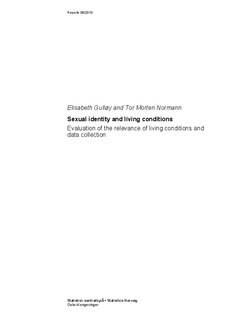| dc.description.abstract | Statistics Norway’s Survey of Living Conditions 2008 was the first to contain
questions on sexual attraction and sexual identity. The survey mainly concerned
health, and was based on a gross sample of 10,000 persons aged 16 years and over.
6,465 persons were interviewed.
This report will present evidence for a correlation between sexual identity and
certain indicators on living conditions. Under certain circumstances, persons
attracted to the same or both sexes and persons identifying themselves as gay,
lesbian or bisexual are exposed to reduced living conditions. However, the
correlations are largely uncertain, and will only in a few cases justify conclusions
that are statistically significant. The main reason for this is the limited number of
observations in groups reporting sexual attraction to the same sex, or a nonheterosexual
identity.
The report also illustrates that inclusion of questions on sexual attraction and
identity did not result in reduced quality due to an increase of non-response in the
living conditions survey as a whole. There was, however, a relatively high
proportion of item non-response in questions on sexual attraction and identity. The
most negative effect was for questions on sexual identity. An analysis of nonrespondents
also indicates a risk of measurement error, due both to item nonresponse
and under-reporting.
The aim of this project, which includes methodological development prior to data
collection, the data collection itself and the present evaluation report, was to
determine whether or not questions on sexual identity should be made a standard
component of Statistics Norway’s surveys on living conditions in the future. In
contrast to other groups in the population, the group of persons with same-sex
attraction or a non-heterosexual identity cannot be objectively defined. In order to
define this group, we have to rely on questions put to the respondents. This also
presupposes that the quality of the questions is good in order to yield high data
quality. Due to the uncertain relationship between sexual identity and living
conditions, and the risk of measurement error, the conclusion of this project is that
these questions should not be included as a standard component of the living
conditions surveys on a regular basis in the future. This does not mean that the
questions may not be asked in the survey again at some stage. If so, one should be
aware of the importance of the sample size necessary in order to obtain significant
results. At the same time, a certain degree of measurement error is to be expected.
Finally, we would like to emphasise that the inclusion of these questions in no way
reduced the general quality of the living conditions survey. ______________Denne rapporten viser at det finnes belegg for å hevde at seksuell tiltrekning og
seksuell identitet kan ha sammenheng med enkelte levekårsindikatorer. Personer
som er tiltrukket av samme eller begge kjønn og personer som identifiserer seg
som homofile, lesbiske eller bifile kan i enkelte tilfeller sies å være utsatt for
svekkede levekår. Sammenhengene er likevel stort sett usikre, og gir bare i få
tilfeller grunnlag for statistisk sikre slutninger. Dette skyldes i all hovedsak at
antallet observasjoner i grupper med tiltrekning til samme kjønn eller en ikkeheterofil
identitet er svært lite.
Rapporten viser også at inkludering av spørsmål om seksuell tiltrekning og
identitet ikke har hatt negativ innvirkning på resten av levekårsundersøkelsen i
form av økt frafall. Spørsmålene om seksuell tiltrekning og identitet er imidlertid
noe beheftet med partielt frafall. Størst betydning har dette for seksuell identitet. En
analyse av frafallet viser at det er en fare for målefeil, både på grunn av partielt
frafall og underrapportering. | no_NO |
